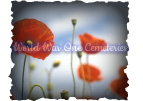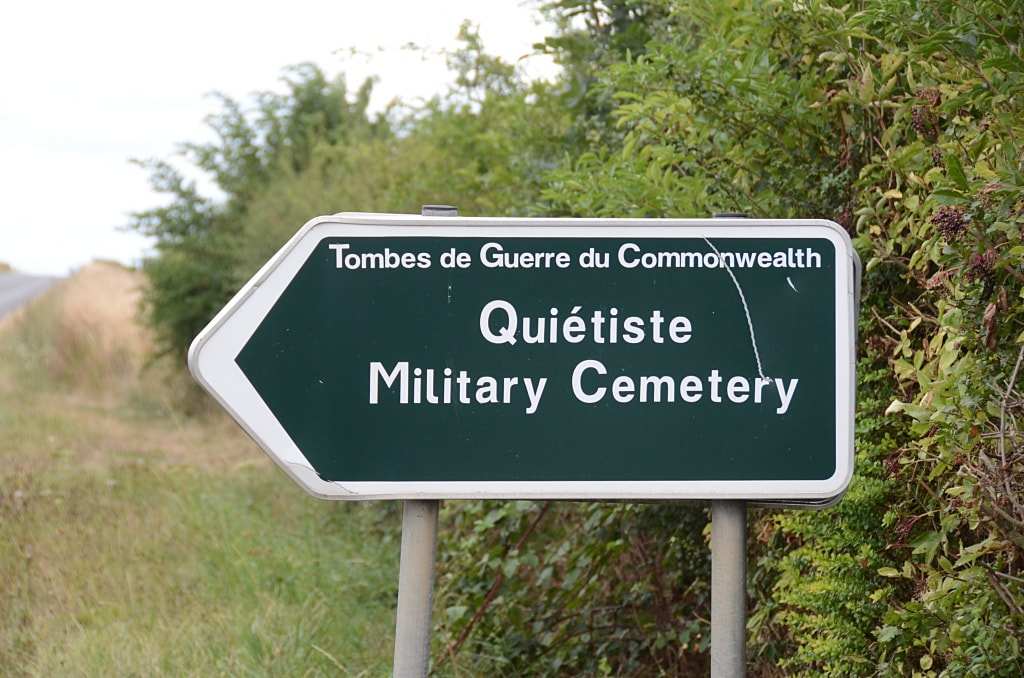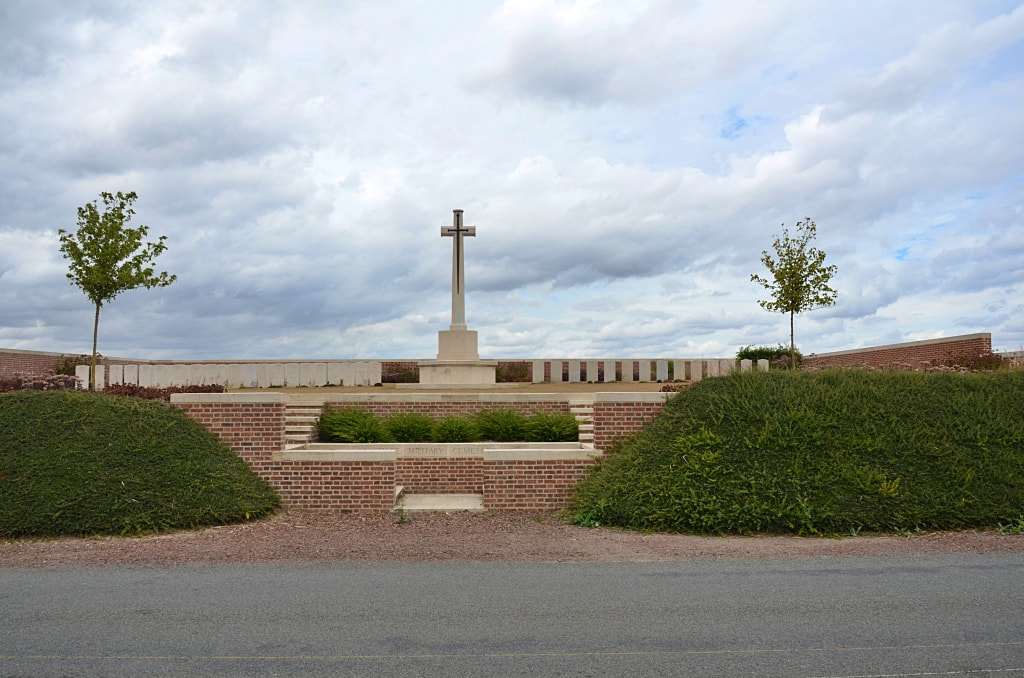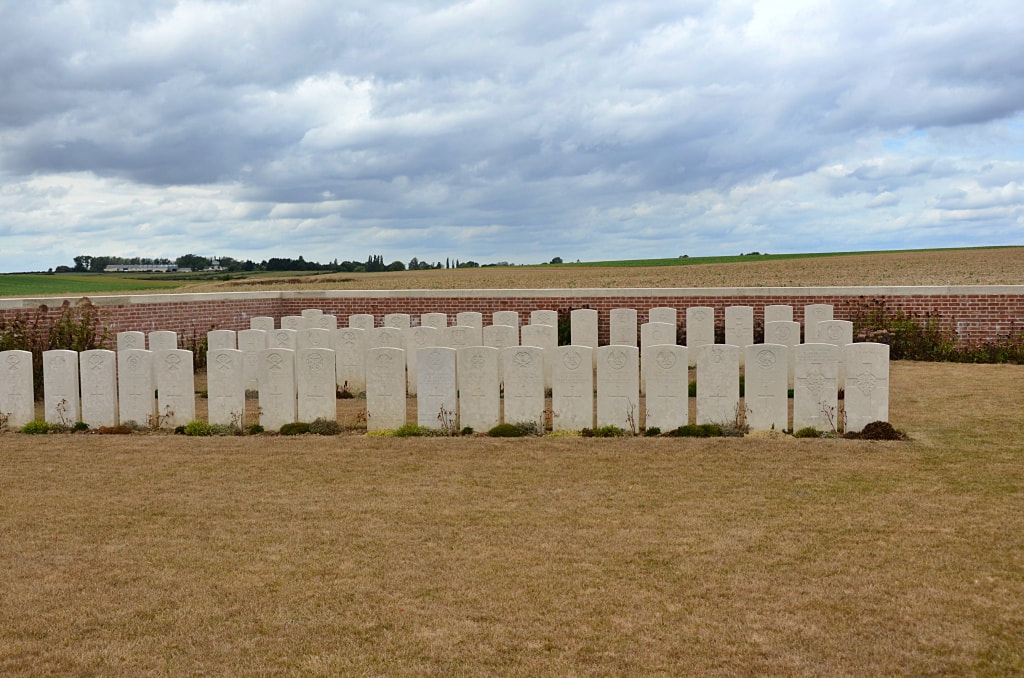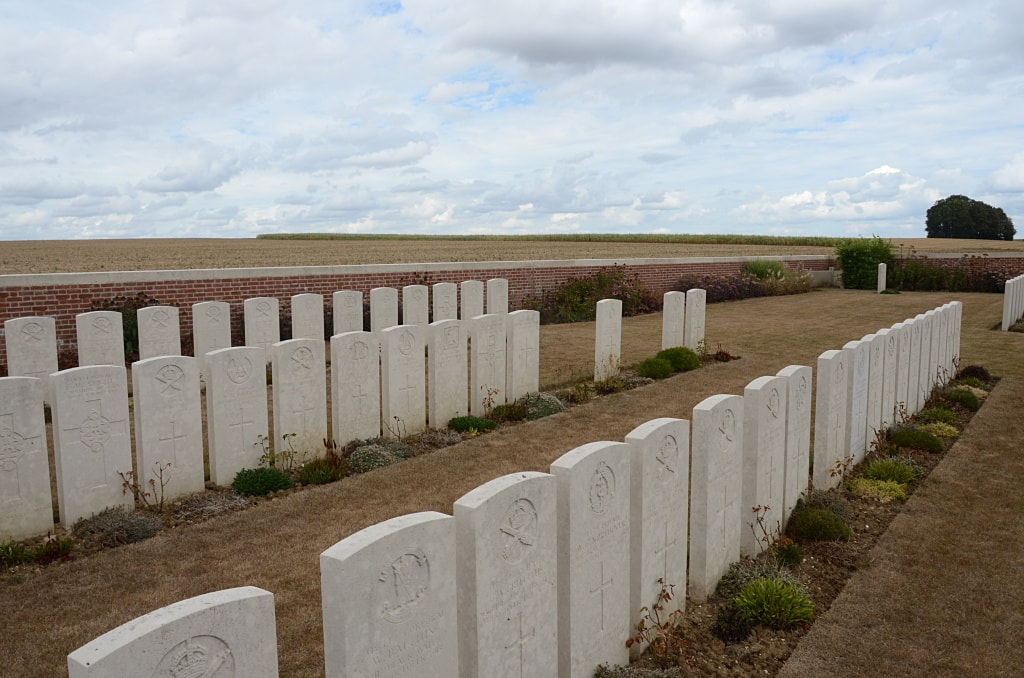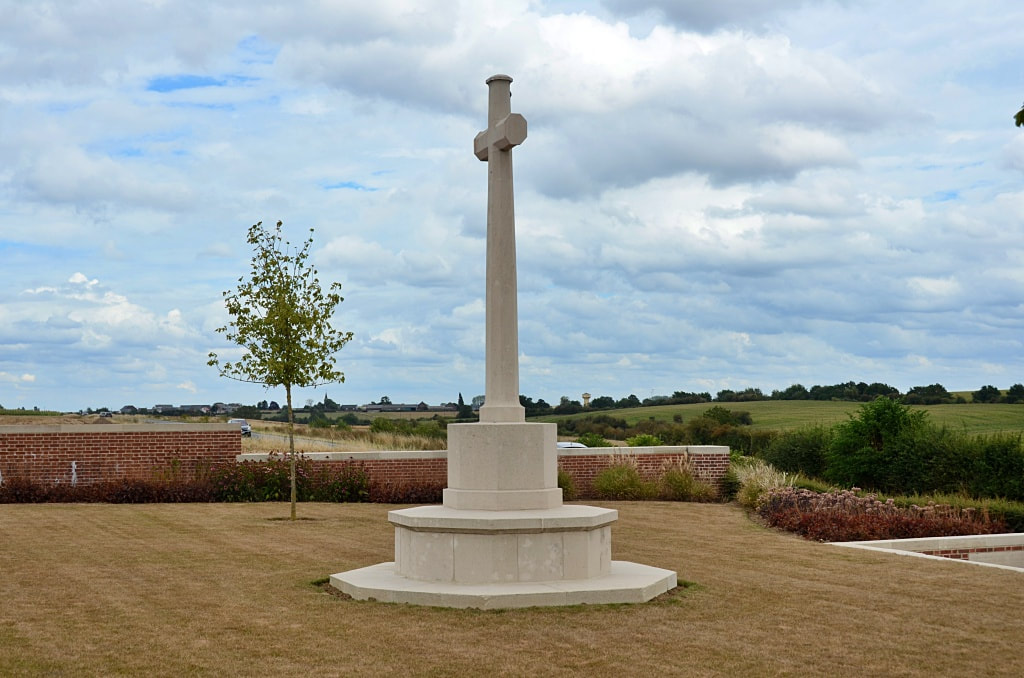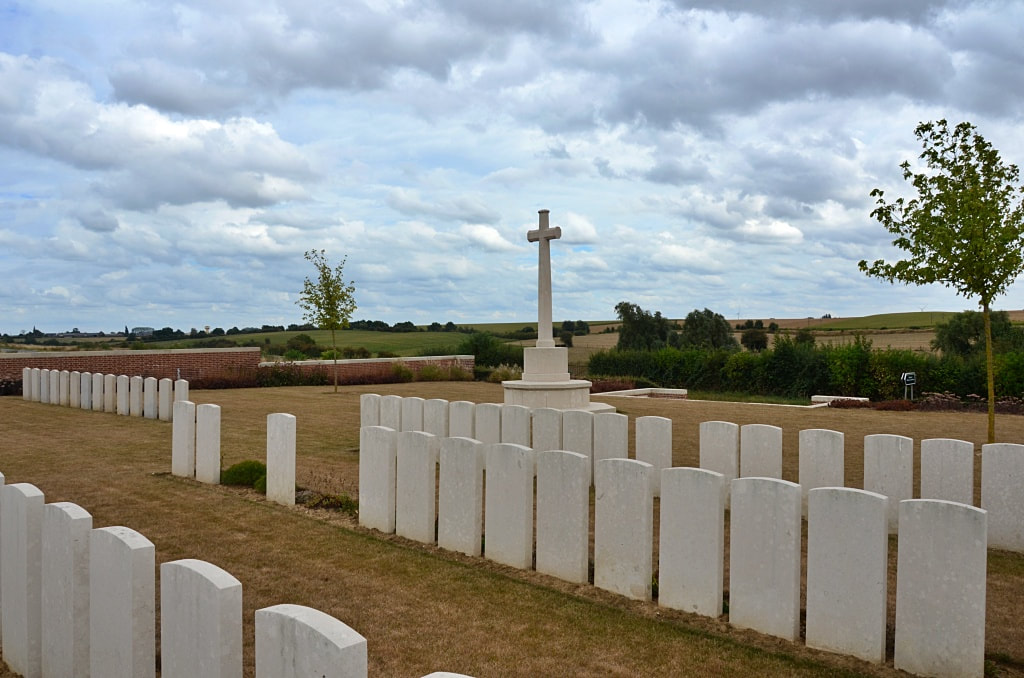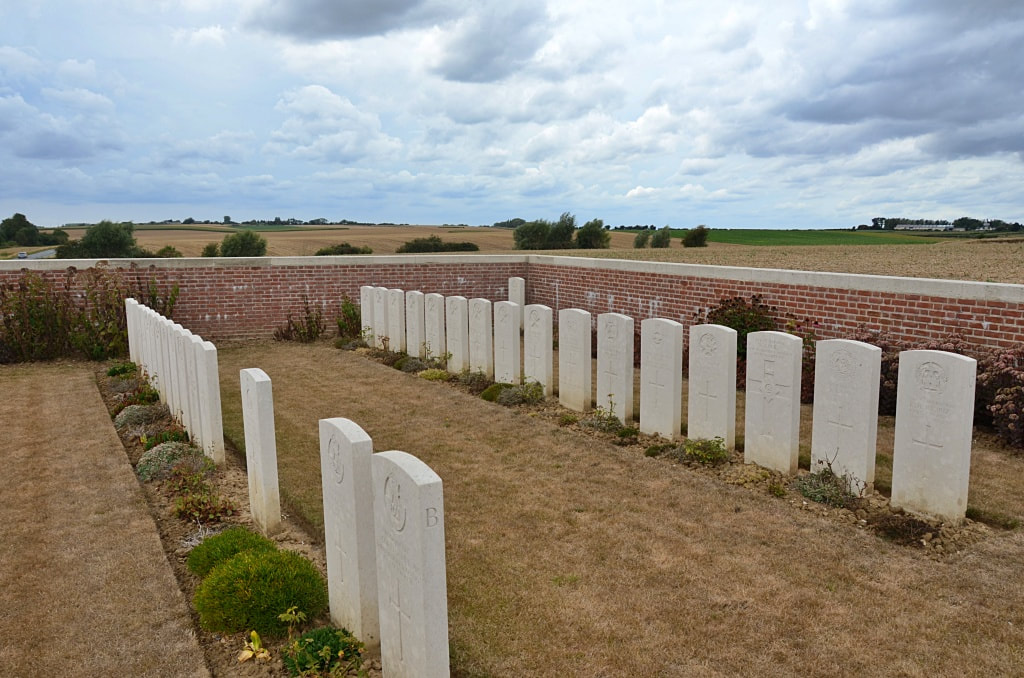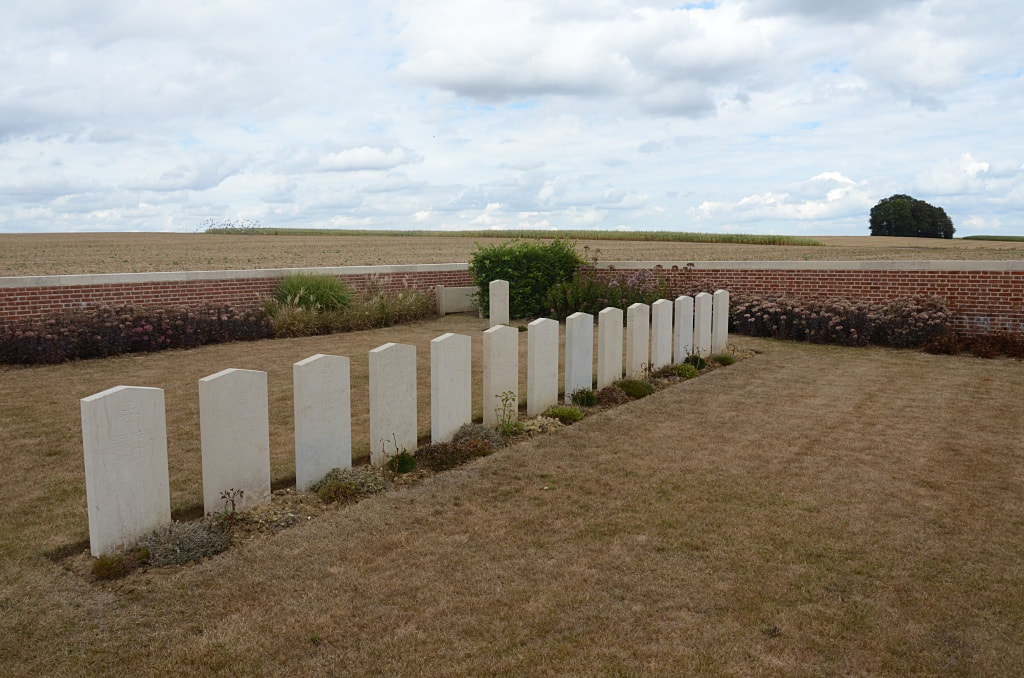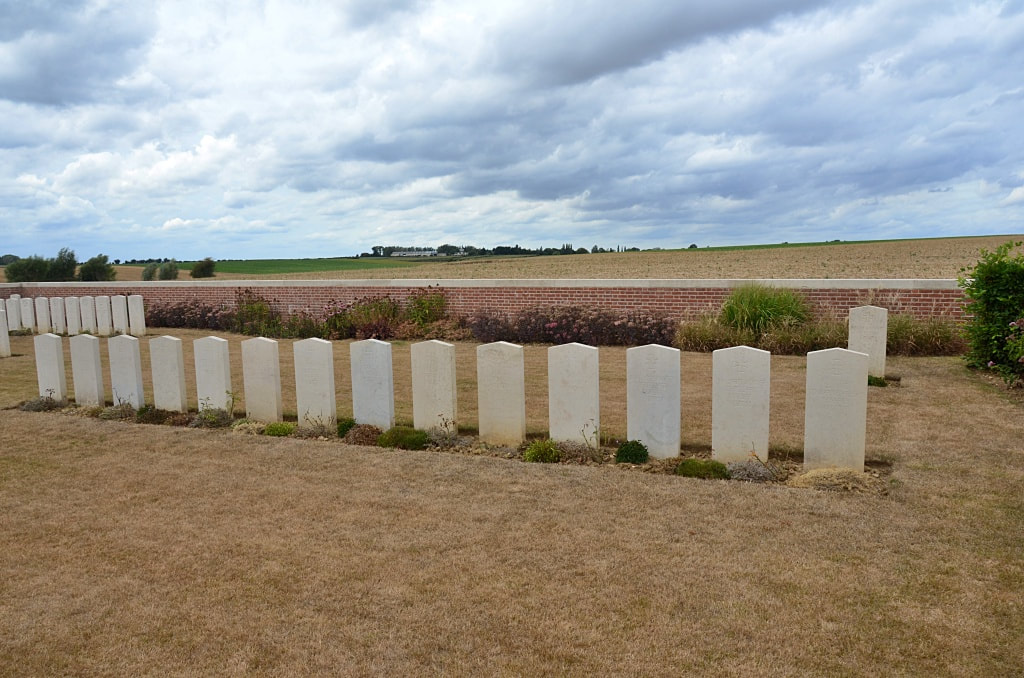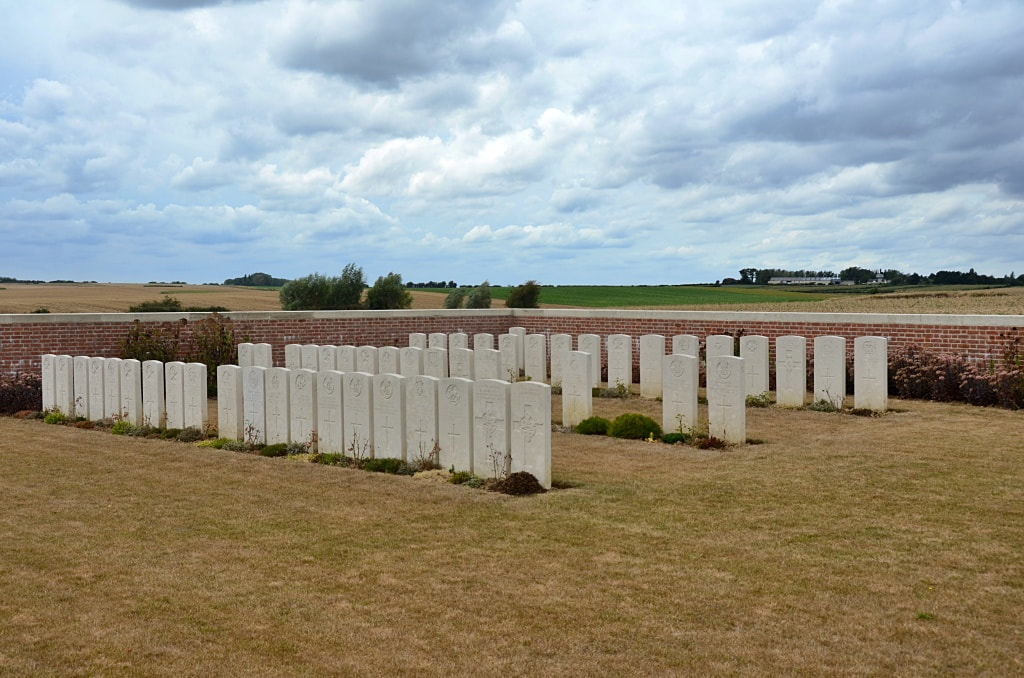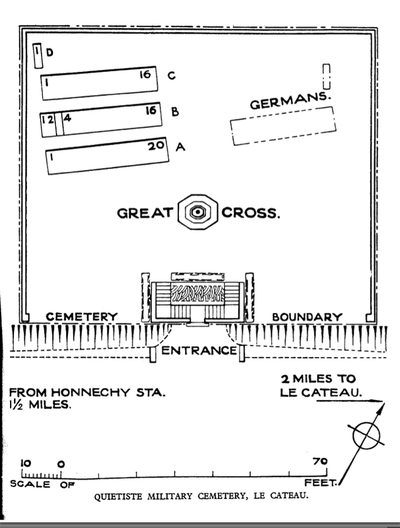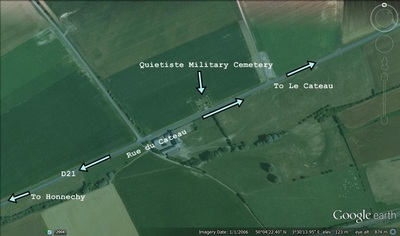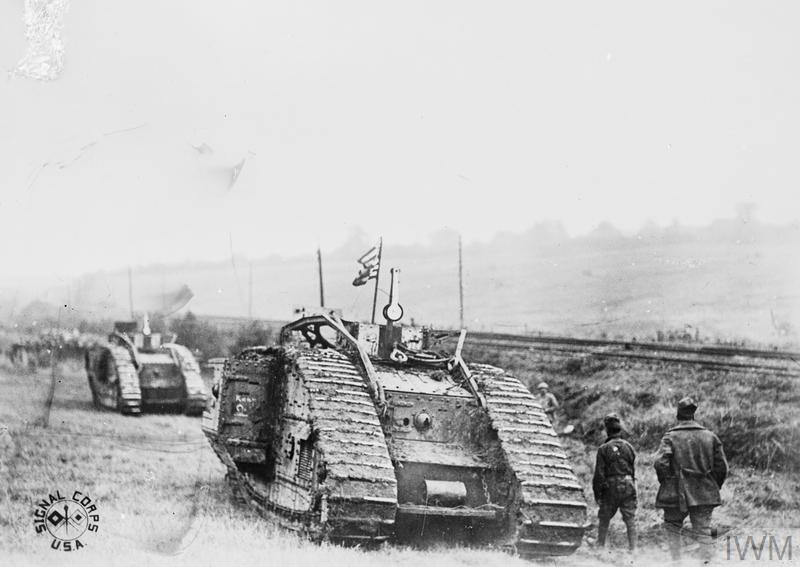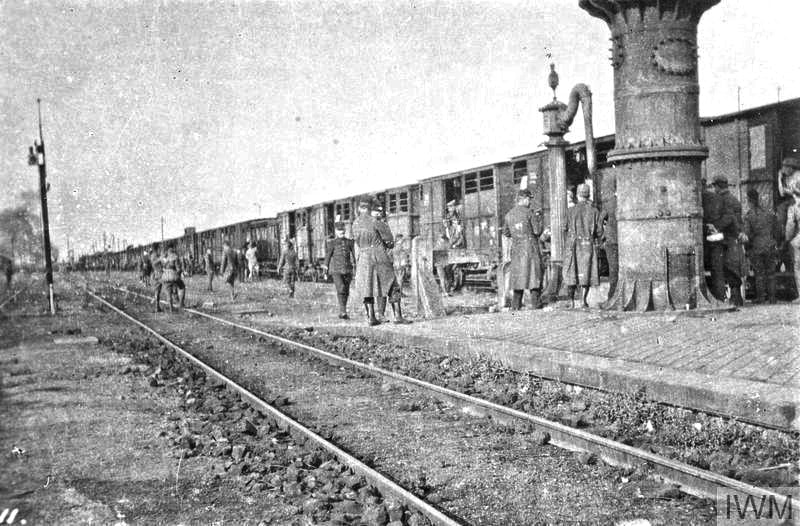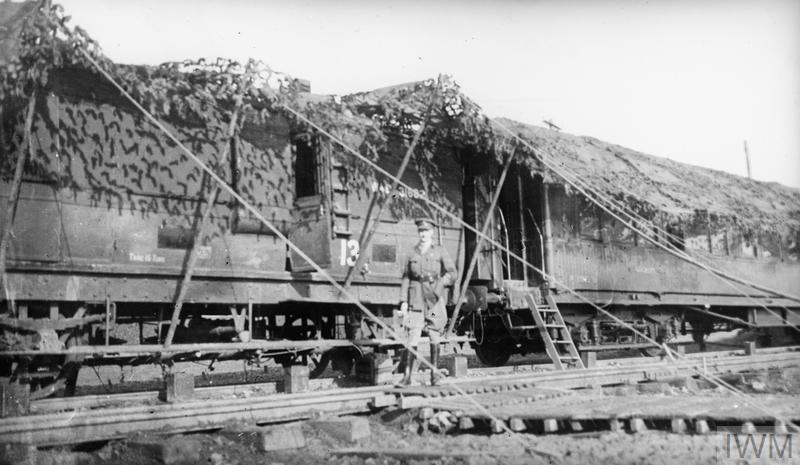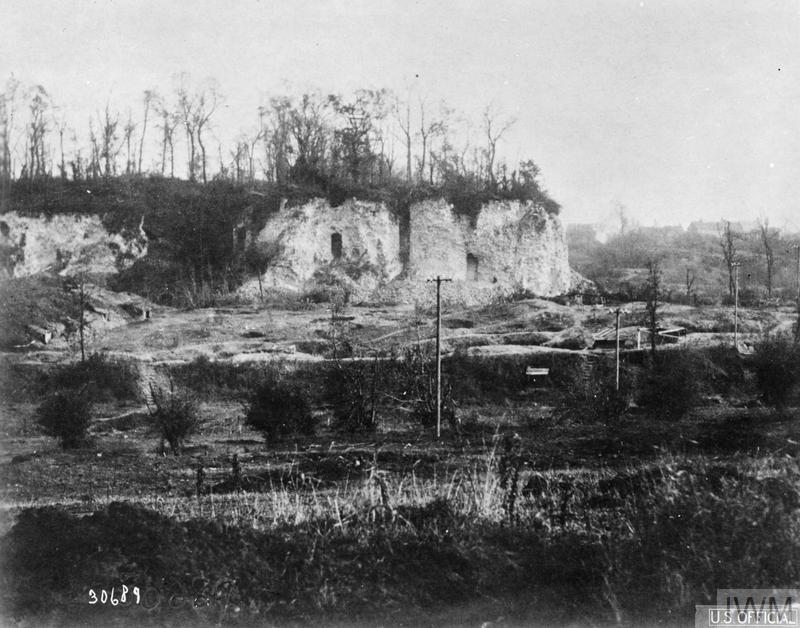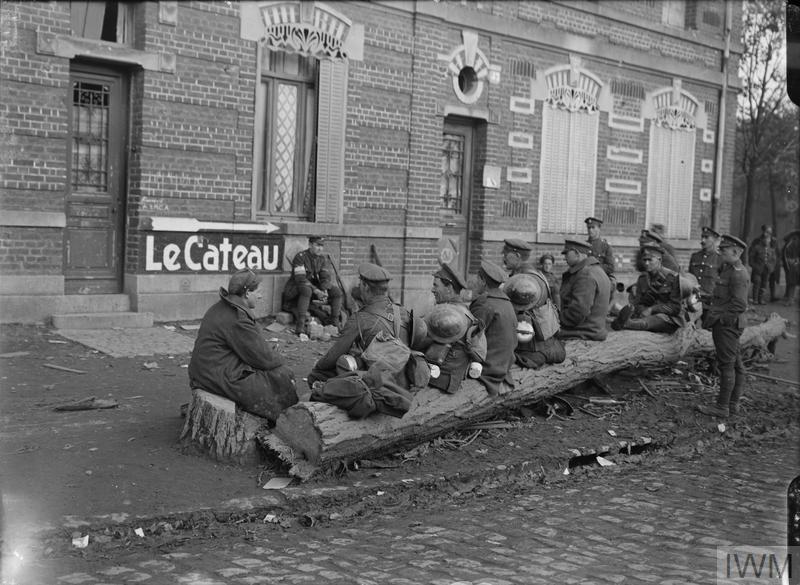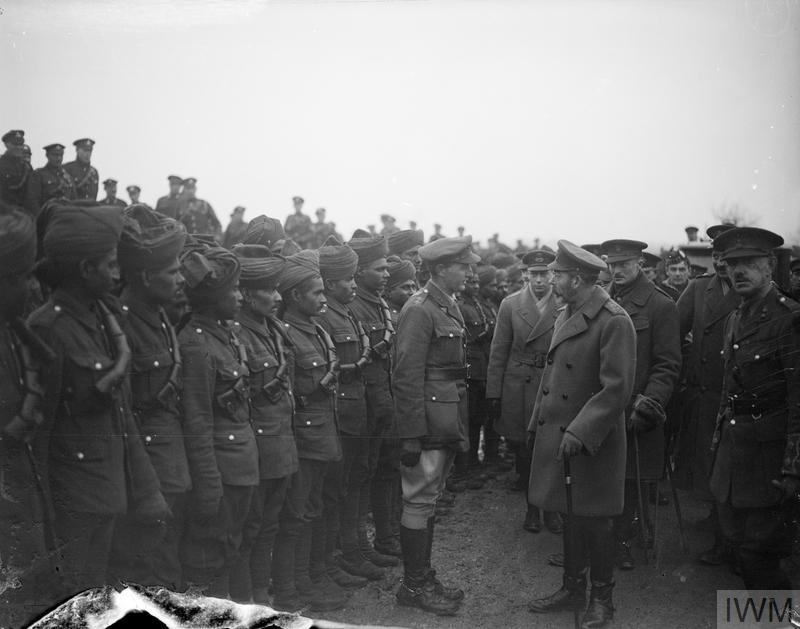QUIÉTISTE MILITARY CEMETERY
Le Cateau
Nord
France
GPS Coordinates: Latitude: 50.07303, Longitude: 3.50409
Location Information
Quietiste Military Cemetery is half-way from Le Cateau to Busigny, on the north-west side of the road (D21).
Visiting Information
The location or design of this site make wheelchair access impossible.
The register is available in the Office de Tourisme on Monday to Saturday from 9.30 to 12.30 and from 14.00 to 18.00 -
closed on Tuesday and Sunday
Historical Information
Le Cateau and the country West of it, were the scene of the rearguard battle fought by the II Corps on the 26th August, 1914, against a greatly superior German force; it then passed into German hands, and became a railhead and an important hospital centre. It was stormed by the 5th Connaught Rangers on the evening of the 10th October, 1918, and cleared during the following week.
Quietiste Military Cemetery was made in October, 1918, by the 50th (Northumbrian) Division, as "Farm Cemetery"; the present name was acquired before the end of 1918, and is due to some association with Fenelon, Bishop of Cambrai, whose country house at Honnechy, 2.4 kilometres West, was used by both sides as Divisional Headquarters.
There are now over 50, 1914-18 commonwealth war casualties commemorated in this site.
The cemetery covers an area of 683 square metres and is enclosed by a brick wall, except on the roadside.
Total Burials: 67.
Identified Casualties: United Kingdom 49, Germany 10.
Unidentified Casualties: Germany 5, United Kingdom 3. Total 8.
The cemetery was designed by William Harrison Cowlishaw
Cemetery images in this gallery © Johan Pauwels
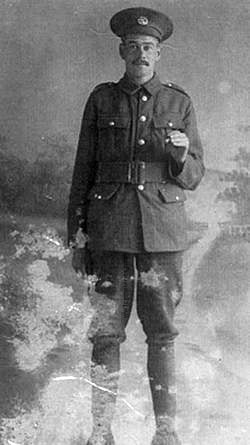
152634 Private
George Elliot Grant
50th Bn. Machine Gun Corps (Infantry)
23rd October 1918, aged 34.
Son of Thomas and Mary Ann Grant of Amesbury, Wiltshire; husband of Elizabeth Grant of Fullerton Wherwell, Hampshire..
George Elliot Grant
50th Bn. Machine Gun Corps (Infantry)
23rd October 1918, aged 34.
Son of Thomas and Mary Ann Grant of Amesbury, Wiltshire; husband of Elizabeth Grant of Fullerton Wherwell, Hampshire..
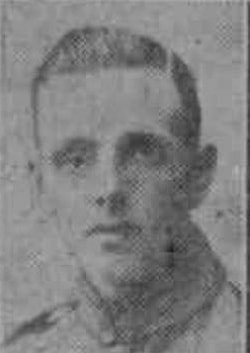
402436 Sapper
Robert Palmer
130th Field Company, Royal Engineers
20th October 1918, aged 26.
Son of Caroline M. Palmer, of 31, Union Terrace, Aberdeen, and the late Robert Palmer.
His headstone bears the inscription "Thy Will Be Done"
Robert Palmer
130th Field Company, Royal Engineers
20th October 1918, aged 26.
Son of Caroline M. Palmer, of 31, Union Terrace, Aberdeen, and the late Robert Palmer.
His headstone bears the inscription "Thy Will Be Done"

Second Lieutenant
Albert Henry Rodgers
50th Bn. Machine Gun Corps (Infantry)
17th October 1918, aged 34.
Row A. 1.
Husband of Mary Rodgers, of 33, Prospect Place, Ashton-on-Ribble, Preston.
His headstone bears the inscription "Gone But Not Forgotten"
The information below supplied by 'The Ellesmerian Club', the alumni organisation for Ellesmere College where Albert was a pupil.
Albert Henry Rodgers
50th Bn. Machine Gun Corps (Infantry)
17th October 1918, aged 34.
Row A. 1.
Husband of Mary Rodgers, of 33, Prospect Place, Ashton-on-Ribble, Preston.
His headstone bears the inscription "Gone But Not Forgotten"
The information below supplied by 'The Ellesmerian Club', the alumni organisation for Ellesmere College where Albert was a pupil.
Albert Henry Rodgers, born on 12th October 1884, at Stretford, Manchester, came to Ellesmere College after Harthill School and stayed for four terms, from September 1899 to December 1900.
His father, a confidential clerk, had died in 1897 and his uncle John Carr, a butcher and farmer, from Fullersmoor Farm, Broxton, Cheshire, was his guardian.
In his short time at Ellesmere, Albert represented the ‘Harold’ dormitory at cricket and was in the team that won the inter-dormitory rugby competition in 1900. He left the college and went into employment as a draper’s apprentice in Chester.
Ten years later, the 1911 Census recorded him as having moved to Preston where he was a draper’s shop assistant. He lived with his sister and her husband at Ashton-on-Ribble.
At the outbreak of war, Albert was a draper / commercial traveller for Jacksons Ltd, based in Preston, Lancashire. On 5th October 1914, Albert signed his Attestation Papers and became Private Rodgers, Service No. 2458 (later to change to 240618) in the 1/5th (Earl of Chester’s) Battalion (Territorial Force), the Cheshire Regiment which had been stationed in Chester in August 1914. The unit moved then to Shrewsbury, onto Northampton and then to Cambridge. He was promoted Lance Corporal on 29th March 1915, whilst based at Northampton and this was where the only entry on his conduct sheet was made. He was late for the 9.30pm roll call one evening and was ‘reprimanded’. This did not, however, hamper his further promotion to full Corporal on 23rd August four days after his arrival in France.
Exactly where, or when, Albert saw active service is not recorded. He was promoted Lance Sergeant on 28thApril 1916. On 2nd July he suffered a gun-shot wound to his left thigh which necessitated his admittance to No. 3 General Hospital at Le Treport. This hospital was, in fact, the Hotel Trianon, which had been requisitioned for the duration of the war. From here, he was transferred to No. 7 Canadian General Hospital prior to his being evacuated to England on 4th July.
On arrival in England he was then transferred to Chester Hospital. He returned to his unit on 17th December. March 1917 saw him posted to the 4th (Reserve) Battalion, The Cheshire Regiment.
On 27th April 1917 he formally applied for a temporary commission in the Regular Army. At the time he was Lance Sergeant Rodgers, Service No. 240618, and based at Park Hall Camp, just outside Oswestry and only some six miles from his old college. The Ellesmerian does not record if he ever visited whilst stationed there but the Headmaster, the Reverend T. H. Hedworth provided the necessary character reference for him.
His application was successful and he was instructed to report to No. 12 Officer Cadet Battalion at Newmarket on 7th September. Three months later, having already served over three years ‘in the ranks’, he completed the necessary training and was commissioned to the Durham Light Infantry as a 2nd Lieutenant.
With this regiment he fought on the Somme and in the Battles of Lys. On 13th May he transferred to the 50th Battalion, the Machine Gun Corps.
On 17th October 1918, the Fourth Army, under Rawlinson’s command, began the Battle of the Selle with an attack on a ten mile front south of Le Cateau. It was one attack too many for Albert for he was killed on the opening day of the battle.
For his military service Albert was awarded the Victory Medal, the British War Medal and the 1914-1915 Star. He was buried in the Quietiste Military Cemetery, Le Cateau only days after his 34th birthday. He was just one of 12,530 men who fought with the Durham Light Infantry and who lost their lives during the conflict. He left behind a widow, Mary Rodgers, whom he had married in the autumn of 1915.
His father, a confidential clerk, had died in 1897 and his uncle John Carr, a butcher and farmer, from Fullersmoor Farm, Broxton, Cheshire, was his guardian.
In his short time at Ellesmere, Albert represented the ‘Harold’ dormitory at cricket and was in the team that won the inter-dormitory rugby competition in 1900. He left the college and went into employment as a draper’s apprentice in Chester.
Ten years later, the 1911 Census recorded him as having moved to Preston where he was a draper’s shop assistant. He lived with his sister and her husband at Ashton-on-Ribble.
At the outbreak of war, Albert was a draper / commercial traveller for Jacksons Ltd, based in Preston, Lancashire. On 5th October 1914, Albert signed his Attestation Papers and became Private Rodgers, Service No. 2458 (later to change to 240618) in the 1/5th (Earl of Chester’s) Battalion (Territorial Force), the Cheshire Regiment which had been stationed in Chester in August 1914. The unit moved then to Shrewsbury, onto Northampton and then to Cambridge. He was promoted Lance Corporal on 29th March 1915, whilst based at Northampton and this was where the only entry on his conduct sheet was made. He was late for the 9.30pm roll call one evening and was ‘reprimanded’. This did not, however, hamper his further promotion to full Corporal on 23rd August four days after his arrival in France.
Exactly where, or when, Albert saw active service is not recorded. He was promoted Lance Sergeant on 28thApril 1916. On 2nd July he suffered a gun-shot wound to his left thigh which necessitated his admittance to No. 3 General Hospital at Le Treport. This hospital was, in fact, the Hotel Trianon, which had been requisitioned for the duration of the war. From here, he was transferred to No. 7 Canadian General Hospital prior to his being evacuated to England on 4th July.
On arrival in England he was then transferred to Chester Hospital. He returned to his unit on 17th December. March 1917 saw him posted to the 4th (Reserve) Battalion, The Cheshire Regiment.
On 27th April 1917 he formally applied for a temporary commission in the Regular Army. At the time he was Lance Sergeant Rodgers, Service No. 240618, and based at Park Hall Camp, just outside Oswestry and only some six miles from his old college. The Ellesmerian does not record if he ever visited whilst stationed there but the Headmaster, the Reverend T. H. Hedworth provided the necessary character reference for him.
His application was successful and he was instructed to report to No. 12 Officer Cadet Battalion at Newmarket on 7th September. Three months later, having already served over three years ‘in the ranks’, he completed the necessary training and was commissioned to the Durham Light Infantry as a 2nd Lieutenant.
With this regiment he fought on the Somme and in the Battles of Lys. On 13th May he transferred to the 50th Battalion, the Machine Gun Corps.
On 17th October 1918, the Fourth Army, under Rawlinson’s command, began the Battle of the Selle with an attack on a ten mile front south of Le Cateau. It was one attack too many for Albert for he was killed on the opening day of the battle.
For his military service Albert was awarded the Victory Medal, the British War Medal and the 1914-1915 Star. He was buried in the Quietiste Military Cemetery, Le Cateau only days after his 34th birthday. He was just one of 12,530 men who fought with the Durham Light Infantry and who lost their lives during the conflict. He left behind a widow, Mary Rodgers, whom he had married in the autumn of 1915.
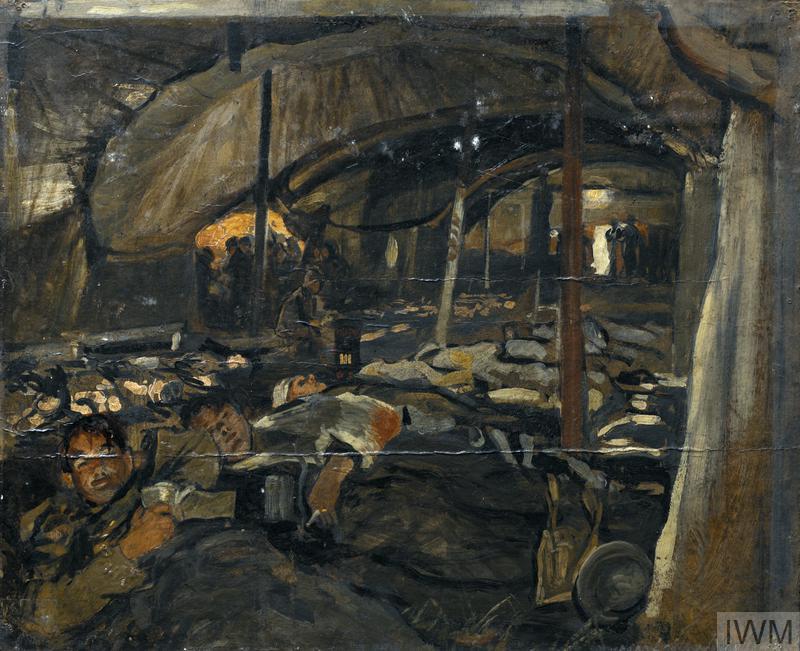
Le Cateau; The interior of a large tent, supported by large wooden poles, filled with wounded British soldiers lying on stretchers on the ground. The foremost wounded soldier looks comfortable, with his left arm placed behind his head. The casualty next to him has his arm bandaged up in a sling, with a bloodstain on the bandage towards his elbow. (Artist; J. Hodgson Lobley) © IWM (Art.IWM ART 3800)
